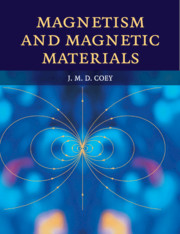Book contents
- Frontmatter
- Contents
- List of tables of numerical data
- Preface
- Acknowledgements
- 1 Introduction
- 2 Magnetostatics
- 3 Magnetism of electrons
- 4 Magnetism of localized electrons on the atom
- 5 Ferromagnetism and exchange
- 6 Antiferromagnetism and other magnetic order
- 7 Micromagnetism, domains and hysteresis
- 8 Nanoscale magnetism
- 9 Magnetic resonance
- 10 Experimental methods
- 11 Magnetic materials
- 12 Applications of soft magnets
- 13 Applications of hard magnets
- 14 Spin electronics and magnetic recording
- 15 Special topics
- Appendices
- Formula index
- Index
- Tables, conversions, constants and units
8 - Nanoscale magnetism
Published online by Cambridge University Press: 05 June 2012
- Frontmatter
- Contents
- List of tables of numerical data
- Preface
- Acknowledgements
- 1 Introduction
- 2 Magnetostatics
- 3 Magnetism of electrons
- 4 Magnetism of localized electrons on the atom
- 5 Ferromagnetism and exchange
- 6 Antiferromagnetism and other magnetic order
- 7 Micromagnetism, domains and hysteresis
- 8 Nanoscale magnetism
- 9 Magnetic resonance
- 10 Experimental methods
- 11 Magnetic materials
- 12 Applications of soft magnets
- 13 Applications of hard magnets
- 14 Spin electronics and magnetic recording
- 15 Special topics
- Appendices
- Formula index
- Index
- Tables, conversions, constants and units
Summary
Nanoscale magnets have at least one dimension in the nanometre range. They exhibit size-specific magnetic properties such as superparamagnetism, remanence enhancement, exchange averaging of anisotropy and giant magnetoresistance when the small dimensions become comparable to a characteristic magnetic or electrical length scale. Thin films are the most versatile magnetic nanostructures, and interface effects such as spin-dependent scattering and exchange bias influence their magnetic properties. Thin-film stacks form the basis of modern magnetic sensors and memory elements.
Matter behaves differently down in the nanoworld, where the length scales of interest range from about 1 nm up to about 100 nm. The atomic-scale structure of matter can usually be ignored, but the mesoscopic dimensions of the magnetic nano-objects are comparable to some characteristic length scale, below which the physical properties change. We have already encountered one important nanoscale object in bulk magnetic material – the domain wall. It is extended in two directions, but not in the third; the domain wall width δw is one of the characteristic lengths that concern us here.
The number of small dimensions in a nanoscale magnet may be one, two or three. Some examples of each are illustrated in Fig. 8.1. The one-small-dimension class includes magnetic thin films, which are at the heart of many modern magnetic devices. Magnetic and nonmagnetic layers can be stacked to make thin-film heterostructures, such as spin valves and tunnel junctions. The films are usually grown on a macroscopic substrate.
- Type
- Chapter
- Information
- Magnetism and Magnetic Materials , pp. 264 - 304Publisher: Cambridge University PressPrint publication year: 2010
- 2
- Cited by

